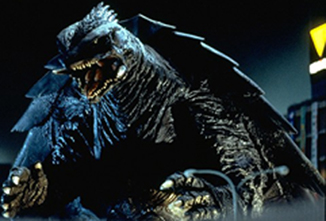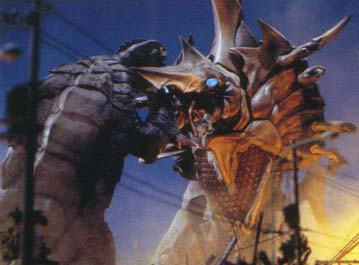 Until 1995, Gamera was the joke: about as low as you could go in the land of Giant Monsters…unless you went to the real out-of-the-way backwaters, like Hong Kong, or South Korea. He was, at best, a Godzilla rip-off, and even nerds like us look down on those. The fire-breathing clown palled around with the kids when he should have been out handing Tokyo its ass. Oh, sure, he saved the world…but from what? A giant salamander with an opal fetish? A telepathic shark from Outer Space? A star fish? I mean, c’mon. Even the Flash has better villains.
Until 1995, Gamera was the joke: about as low as you could go in the land of Giant Monsters…unless you went to the real out-of-the-way backwaters, like Hong Kong, or South Korea. He was, at best, a Godzilla rip-off, and even nerds like us look down on those. The fire-breathing clown palled around with the kids when he should have been out handing Tokyo its ass. Oh, sure, he saved the world…but from what? A giant salamander with an opal fetish? A telepathic shark from Outer Space? A star fish? I mean, c’mon. Even the Flash has better villains.
It was easy to pick on Gamera. It was fun. Not so easy any more. Because Gamera has become the pinnacle. The new high water mark in giant monster cinema. In Gamera 3, the wave broke, just in time for the Millennium. Remember when the world ended? Yeah, so do I. Remember how seriously we all took that? As if it actually mattered? Well, imagine how it felt to our Japanese brothers and sisters. There’s a palatable sense of impending doom throughout Gamera 3, adding weight and drama to the proceedings and turning this story (and its giant turtle protagonist) into more than the sum of their rubbery parts. {More}

 A large meteor
A large meteor Looking back, Gamera’s rebirth was almost inevitable. History repeats itself and the movie industry eats its dead. Inspired by the success of the modern Godzilla films (beginning with 1984’s Godzilla and ending, on a dower, cliffhanger-note in 1995’s Godzilla vs. Destroyah), Daiei brought their own terrible terrapin out of retirement exactly nine months before Godzilla’s (latest) death. In black and white, as I’ve mentioned, Gamera can be somber, dynamic, dark…creepy in his own, lantern-eyed way. But the advent of cheap color film technology was no friend to the Friend to Children Everywhere.
Looking back, Gamera’s rebirth was almost inevitable. History repeats itself and the movie industry eats its dead. Inspired by the success of the modern Godzilla films (beginning with 1984’s Godzilla and ending, on a dower, cliffhanger-note in 1995’s Godzilla vs. Destroyah), Daiei brought their own terrible terrapin out of retirement exactly nine months before Godzilla’s (latest) death. In black and white, as I’ve mentioned, Gamera can be somber, dynamic, dark…creepy in his own, lantern-eyed way. But the advent of cheap color film technology was no friend to the Friend to Children Everywhere.